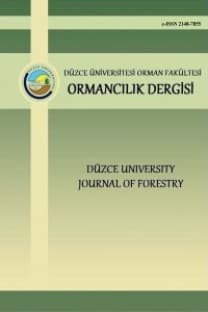Bakteriyel Selüloz Üretimi ve Karakterizasyonu
The Production and Characterization of Bacterial Cellulose
___
- Ateş E, Aztekin K. 2011. Parçacık ve fiber takviyeli polimer kompozitlerin yoğunluk ve basma dayanımı özellikleri, J. Fac. Eng. Arch. Gazi Univversity, Vol 26, No 2, 479-486,
- Bungay HR, Serafica GC. 2000. Production of Microbial Cellulose. US Patent Number: 6,071,727,
- Castro C, Zuluaga R, Álvarez C, Putaux JL, Gloria Caro G, Rojas OJ, Mondragon I, Ganán P. 2012. Bacterial cellulose produced by a new acid-resistant strain of Gluconacetobacter Genus, Carbohydrate Polymers, 89 (4): 1033-1037,
- Castro C, Zuluaga R, Putaux JL, Caroa G, Mondragon I, Ganán P, 2011. Structural characterization of bacterial cellulose produced by Gluconacetobacter swingsii sp. from Colombian agroindustrial wastes, Carbohydrate Polymers, Volume 84, Issue 1, 11 February, Pages 96–102,
- Cheng KC, Catchmark JM, Demirci A. 2009. Enhanced production of bacterial cellulose by using a biofilm reactor and its material property analysis, Journal of Biological Engineering, 3 (12), doi:10.1186/1754-1611-3-12,
- Fabio P. Gomes, Nuno H.C.S. Silva, Eliane Trovatti, Luisa S. Serafim, Maria F. Duarte, Armando J.D. Silvestre, Carlos Pascoal Neto , Carmen S.R. Freire. 2013. Production of bacterial cellulose by Gluconacetobacter sacchari using dry olive mill residue, Biomass and Bioenergy, 55, 205-211,
- Fu L, Zhang J, Yang G. 2013. Present status and applications of bacterial cellulose-based materials for skin tissue repair, Carbohydrate Polymers, 92: 1432– 1442,
- Gama M, Gatenholm P, Klemm D. 2013. Bacterial NanoCellulose A Sophisticated Multifunctional Material, CRC Press Taylor & Francis Group 6000 Broken Sound Parkway NW, Suite 300 Boca Raton, FL 33487-2742, International Standard Book Number-13: 978-1-4398-6992-5 (eBook - PDF),
- Goh WN, Rosma A, Kaur B, Fazilah A, Karim AA, Bhat R. 2012. Microstructure and physical properties of microbial cellulose produced during fermentation of black tea broth (Kombucha). II., International Food Research Journal 19(1): 153-158,
- Grande CJ, Torres FG, Gomez CM, Troncoso OP, Ferrer JC, Pastor JM. 2009. Development of self-assembled bacterial cellulose–
- ISSN: 2148-7871
- Yayın Aralığı: Yılda 2 Sayı
- Başlangıç: 2005
- Yayıncı: Haldun Müderrisoğlu
Yeşil Alan Donatısının Konut Fiyatlarına Etkisi: Kilis Örneği
Saliha TAŞÇIOĞLU, Ahmet Salih GÜNAYDIN, Murat YÜCEKAYA, M.faruk ALTUNKASA
Bakteriyel Selüloz Üretimi ve Karakterizasyonu
Gökhan GÜNDÜZ, Nejla AŞIK, Deniz AYDEMİR, Ayşenur KILIÇ
Teknik Önlemlerle Heyelan Kontrolu: Ordu İli Çamaş İlçesi Domuşu Heyelanı Örneği
Abdurrahim AYDIN, Diethard LEBER, Remzi EKER, İsmail BULUT, Ertan KESER
Sessiz Kahramanlar: Etkin Mikroorganizmalar
Surhay Ragimoglu ALLAHVERDIEV, Natalia Olegovna MINKOVA, Denis Viktorivich YARIGIN, Gökhan GÜNDÜZ
Karaçam (Pinus Nigra A.) Kerestesinde Eğilme Özelliklerinin Stres Dalga Yöntemiyle Belirlenmesi
Ergün GÜNTEKİN, Zübeyde BÜLBÜL
Zeytin Ağacı (Olea Europaea) Odunun Bazı Fiziksel ve Mekanik Özelliklerinin Belirlenmesi
Gonca DÜZKALE, İbrahim BEKTAŞ, Hasan Hüseyin TUNÇ, Yasin DOĞANLAR
Şemsettin KULAÇ, Ali Kemal ÖZBAYRAM, Zerrin DEĞERMENCİ, Alif Dudu KÜÇÜK, Ali KARADAĞ
